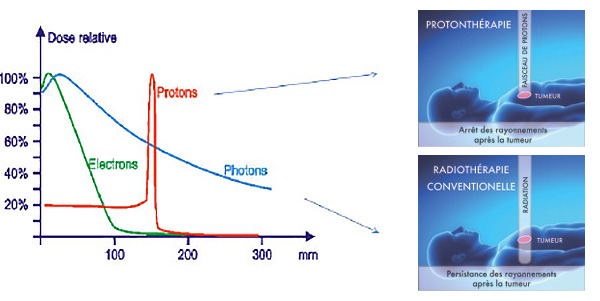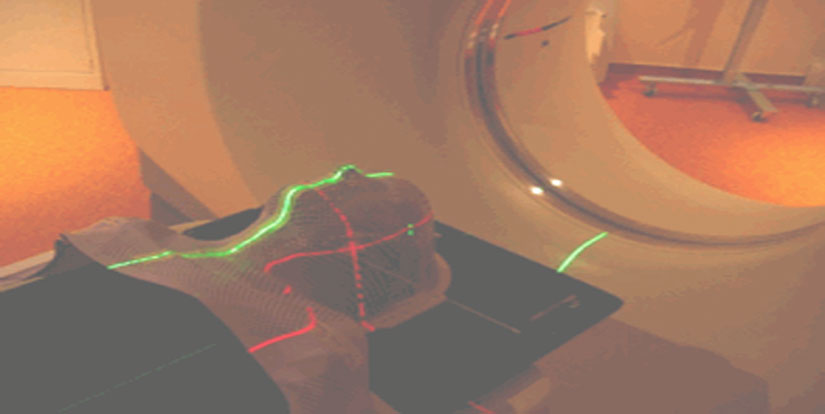What is
Proton therapy ?

General presentation
Proton therapy is a cancer treatment technique as are surgery and chemotherapy.
Proton therapy is a radiotherapy technique. It can be used alone or in combination with surgery and chemotherapy, depending on the type of cancer.
Generally radiation therapy is a technique that involves using ionizing radiation to treat cancers. The patient is placed in a machine that will deliver the radiation at the desired localization. During a radiotherapy session, when delivering radiations, the patient does not feel anything, just like during a radiological examination (CT, MRI, X-ray). The symptoms related to radiation appear after a few days and are mild to moderate intensity. Depending on circumstances, it may be that radiation causes significant symptoms that are predictable; they can be anticipated and cured without sequelae most of the time.
In recent decades, radiotherapy techniques have improved significantly allowing to cure cancer while constantly decreasing toxicities, notably the use of proton particles (known as protontherapy) instead of photon or electrons.
Advantages of proton therapy over other techniques: description of the “Bragg peak”
Proton particles have the distinct advantage over other particles deliver their dose at the tumor without irradiating beyond the tumor which allows to reduce toxicities compared to particles used in routine practice:

Protontherapy course
It is not very different than another radiation treatment. It begins with the consultation with the radiation oncologist (medical doctor that takes care of the radiation treatment) then the virtual computer simulated treatment is made. The case is discussed in a meeting with other doctors to validate or not the indication for proton therapy.
Consultation, virtual simulation, multidisciplinary meeting
Each patient will be seen in consultation by the radiation oncologist to collect all the clinical, radiological and histological information and then present the case in multidisciplinary meeting to validate or not the indication for proton therapy.
The case can be discussed in a multidisciplinary meeting before the consultation with the radiation therapist to speed up procedures and if all the elements of the case are sufficient to make it possible.
Besides obvious clinical indication and prior consultation, a computer simulation of the treatment can be performed to assess the magnitude of the benefit of the proton treatment over a conventional radiotherapy by photons or electrons. Indeed, it may be that conventional treatment is appropriate and that proton therapy is not necessary.

For children :
An anesthesia consultation with parents / guardians and the child will be scheduled in the city of origin or in Nice, if anesthesia is required for all treatment steps. The day of the consultation with the radiation oncologist, the entire process will be presented to the child in a playful way (model, visit the treatment room). For more information on the children management courses, click here
If chemotherapy is associated
A consultation will be held in Nice and / or in the city of origin to prescribe chemotherapy if indicated during radiotherapy.
Simulation CT, treatment planning
The simulation CT does not aim to aid diagnosis but only to acquire images of the lesion in treatment position as to better simulate the treatment on the computer.
For target lesions of the head and neck, a plastic mask on your face will be affixed to mold perfectly the mask as shown in the previous image. It will harden in seconds and will keep the shape of your face which will permit to always treat you in the same position. For other lesions (chest, abdomen, pelvis, arms or legs) mattresses will be perfectly molded to your body, as to always treat you in the same position. Reference points the size of a mole will be tattooed on your skin close to your lesions, as well as on your right and left as to always place you in the same position as in the simulation CT.
In some clinical situations quality imaging (MRI, PET-CT and 18-FDG issued less than a month, CT with contrast injection) will be required to achieve the treatment plan. These exams may be conducted in the city of origin or in Nice.
Irradiation beams are positioned on a computer and the best position of these beams will be simulated in order to target a maximum of the lesion while avoiding as much as possible the healthy tissue. This simulation will begin once all the lesions and healthy tissues are delineated by the radiation oncologist. The calculation requires a period of 7 days.
Treatment, accomodation
Once the treatment is planned and finalized, irradiation sessions can begin. Patients in the Alpes-Maritimes region will come from their homes by their own means or by other means of transport if necessary.
Patients from other regions can benefit from accommodation close to the proton therapy center, “La Consolata”. It is an accommodation structure owned by the Antoine Lacassagne Centre to accommodate patients and their companions from around the world.
The patient benefits from a comprehensive and personalized care where all stages of the course is organized: transport, accommodation, care organization, contacts with the attending physician, possibility of translation
Consolata is located on the hills of Nice, a few minutes from the Mediterranean Institute of Protontherapy in a setting that is both quiet and relaxing, with a panoramic view of the Bay of Angels.
As with any radiation therapy, patients will be seen at least once a week by a radiation oncologist to note all the side effects. They will also be seen on demand in case of problems.
For children, with the Pediatric Hospital of Nice Lenval Hospital, specialized in surgery, Archet Hospital with its Oncology-Hematology Ward and the Centre Antoine Lacassagne, Nice’s radiotherapy pole- only establishment authorized in the Nice territory to treat with radiation therapy both adults and children – the Nice area can propose a comprehensive care network for children with cancer.
Is proton therapy suitable for my disease?
Proton therapy
Proton therapy is not always suitable for all situations because it is not all the time necessary to use the precision of this technique as conventional radiation techniques allow more often to treat tumors in excellent conditions.
However, in certain clinical situations, the use of proton therapy reduces the toxicities that occur during irradiation but also the very long term toxicities (intellectual disorders, stroke, radiation-induced cancer, hormone deficiencies, etc. …).
Proton therapy is used primarily to reduce the complications of radiotherapy.
Main cancers who may benefit are:
– Children cancers,
– Tumors of the skull base (chordomas, chondrosarcomas, meningiomas),
– Radioresistant paraspinal or pelvic tumors.
For ocular tumors, click here
Depending on the size and location of the tumor:
→ either proton therapy will obviously be more efficient,
→ or conventional radiotherapy may be sufficient,
→ some doubt exists as to the ability of proton therapy to deliver the dose more accurately; in such cases the 2 treatments will be compared virtually to see which is best.

 English
English Deutsch
Deutsch Italiano
Italiano Français
Français Русский
Русский